Guidelines
What is a historical investigation?
It is a written account of between 1,500 and 2,000 words (no more than 2200), divided into three sections, A – Source Analysis, B – Investigation and C – Reflection. The total word count includes in-text citations but not the bibliography.
How many words should there be in each section?
This is no set word limit for each section but one suggestion is:
A – 500 words
B – 1300 words
C – 400 words
What can the investigation be about?
The investigation can consider any genuine historical topic. It can cover topics within the curriculum if you wish and your teacher will approve the choice. No topics that focus on events in the ten years preceding an examination session may be chosen.
When is it done?
You will begin the Internal Assessment during the first semester of Grade 12. The first draft will be due before Christmas and the final piece in February. You will have class time to begin the assessment.
Example of Title Page
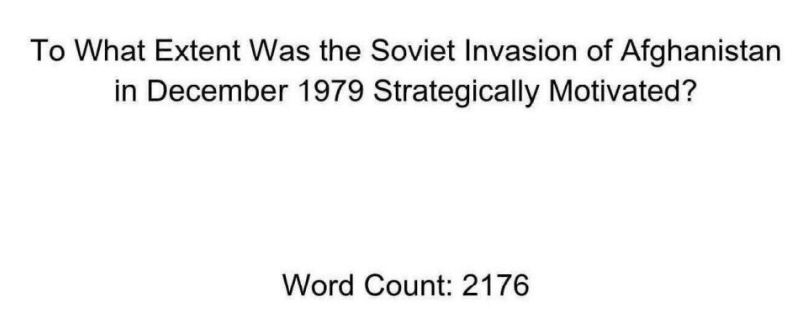
How will it be marked?
The following advice is from ThinkIB, Active History, the advice of other teachers and myself.
Criterion A
In this section, students need to:
- Identification and evaluation of sources.
- State the research question. This should be a narrow focus. Questions about the causation or consequence of an event are probably too large for the IA.
- Why is there an investigation/ controversy/ debate about the issue you have chosen?
- Identify the two sources that they are going to evaluate and state why these sources are relevant to their investigation (they should be named specifically). It is advisable to select one primary and one secondary source although it is not compulsory.
- If you are using a map or cartoon, make sure it is visible in this section.
- Why did you select the two choices? How are they relevant to the investigation?
- Evaluate the two sources in detail referring to the values and limitations of the origins, purposes and content. Focus on balance too, give equal weight to both values and limitations.
- Do not describe or summarise the sources!
- Use words such as value, limitation, hindsight, historian, bias, archives, provenance.
- Research the authors of the source. Think about nationality, specialism, the context in which they are writing/producing, gender, age, education etc.
- Section A builds on the skills that they will already have developed for Question 2 of Paper 1.
- Origin – What are the factors which influenced the publication/ production of the source? Think about political, economic, social or military events. This requires a lot of research to find out the answers. For example, if you find an article that was published in Munich in 1939, you can identify several influences,
a. Munich was a strong Nazi city. Although the March 1933 election only gave 45-50% of the vote to the NSDAP in the city, it had become the capital of the movement and held the important Munich Conference in 1938. This may have influenced the objectivity of the article as the author could be inspired by events or fearful of recriminations if they were critical of the government.
b. Even if the author was sympathetic to minorities such as the Jews, events such Kristallnacht in 1938 or the Nuremberg Laws of 1935 would deter them from writing freely.
c. Even though Hitler won only one-third of the vote in the November 1932 election, his popularity and reputation was enhanced within Germany because of his foreign policy successes (Saar 1935, Rhineland 1936, Anchluss 1938) and a return to seemingly economic growth (the Nazi propaganda was clearly a factor in people’s perceptions). This could influence the content and analysis of the article in favour of Hitler.
- Sentence starters:
This investigation seeks to answer the question “…
In order to maintain a clear focus, the study will (only) analyse…
One key source managed for the investigation was…
This was chosen because…
The source was written by….which is a major value/limitation for this investigation as…
It was produced in…., making it a primary/secondary source for this study. This is a value/limitation as…
The source is a (e.g. speech), which is also a value/limitation to this study because….
The purpose of the source is to inform/persuade the reader about…This makes it valuable/limited to this investigation as….
The source’s content is particularly valuable to the source, for example…
Aim for one-hundred words for the introduction and two-hundred for each source.
Example of an introductory paragraph

Criterion B
This is the main investigation. As such it needs to include the following:
- a clear focus on the research question. As with Papers II and III, you should link your analysis to the question and/or thesis statement.
- critical analysis of the issue
- different perspectives, explain why. Aim to be balanced.
- reference to a range of sources, including those in Section A.
- ensure you write a bibliography which includes all the sources you have used.
It is important that you thoroughly research your topic. You should aim for academic sources rather than superficial websites. For example, use JStor rather than history.com. The latter is useful for background information but the material may not have been thoroughly investigated and the content is geared towards a specific audience. Furthermore, it does not always include the author.
As with any essay, it needs to be clearly structured and end with a conclusion that addresses the question and which is consistent with the argument that has been put forward in the main body of the investigation. It is recommended that you include THREE articles or books and TWO websites to reference within the investigation. You have also included intext citations.
DO NOT
- Use extensive footnotes to ensure you are within the word limit. If the information is relevant, make sure it is part of the investigation.
- Write the conclusion with a new argument or piece of evidence.
The following advice is from Active History.
Introduction (c. 100-150 words)
• Set the scene / generate reader interest by establishing why this question was important at the time, and remains relevant today.
• Summarise the different historical perspectives that exist in relation to the question.
• Outline how the essay will be structured, and the main conclusions that will be reached.
Main Body (c. 1000-1100 words)
- Evaluate the evidence for several different perspectives in separate paragraphs.
- Within each paragraph, start with a clear topic sentence which is clearly focused on the question. Then explain it with carefully selected and properly referenced evidence (use quotes as necessary).
- Ensure that you stress the value of the evidence you use, but also acknowledge its limitations, with reference to Origin, Purpose and Content as appropriate.
Conclusion (c. 100-150 words)
Provide a direct answer to the question you set yourself by synthesizing the main points of the essay. In particular, stress which historical perspective you agree with most and why, and which historical perspective you reject and why, or whether you think it is possible to accept different elements of different perspectives to provide a new interpretation.
Example of how to begin the Investigation.

Criterion C
Criterion C is the refection part of the essay. The refection is very different from the reflection part of the Extended Essay or for that done as part of CAS. It is a reflection about the work of a historian and should show what the student has learned about the methodology of a historian and also about the challenges faced by a historian. In this sense, it is linked very much to TOK.
It is a good idea to work with the TOK teachers before doing this section to check that history has been covered in TOK. It is important that students link their thoughts on the methods/challenges of historians to their actual essay and do not just talk generally about methods of and the challenges facing historians.
- If candidates state that finding relevant information on the topic was a challenge, credit will not be awarded. However, if they explain that such
a challenge is also faced by historians and can effectively link it to their investigation, then their point could be made relevant.
Example of how to begin the Reflection.

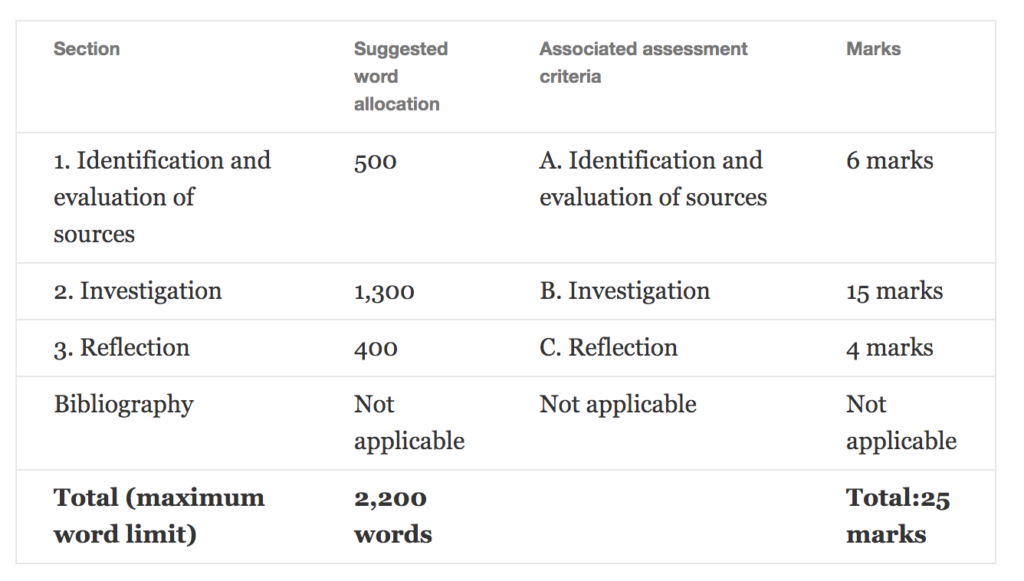
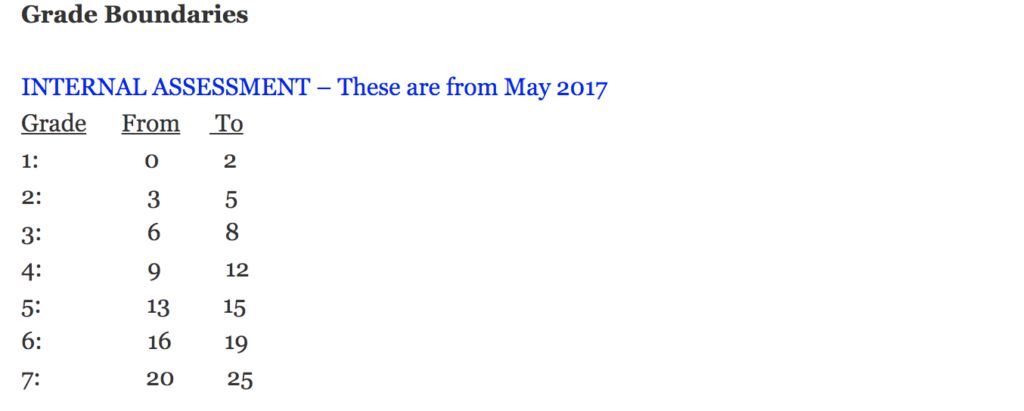
Further guidance is from ActiveHistory and IB Historyia. I recommend you refer to both to help both your research and analysis.
IA Rubric

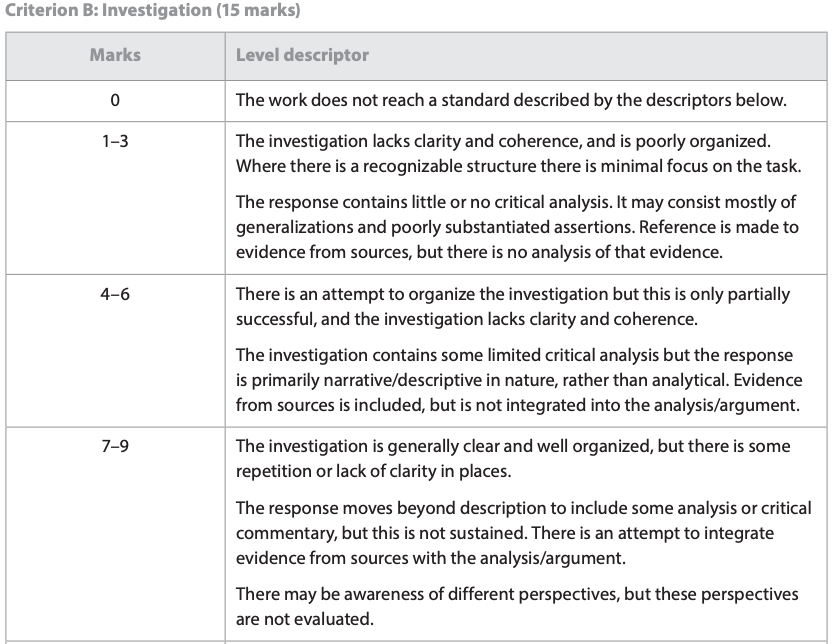
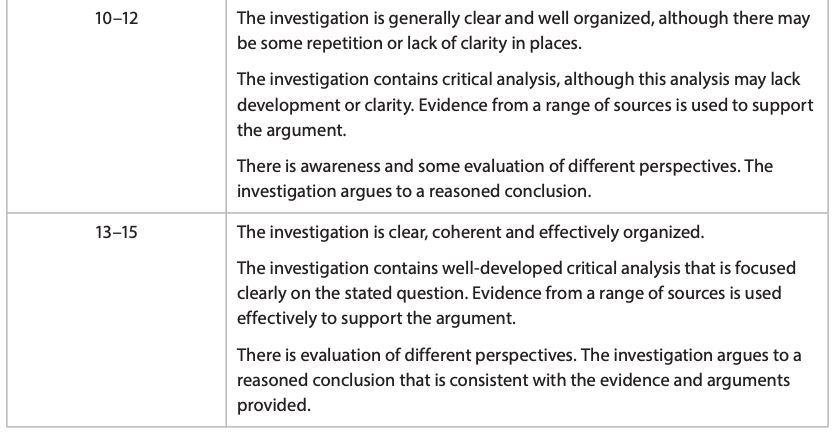
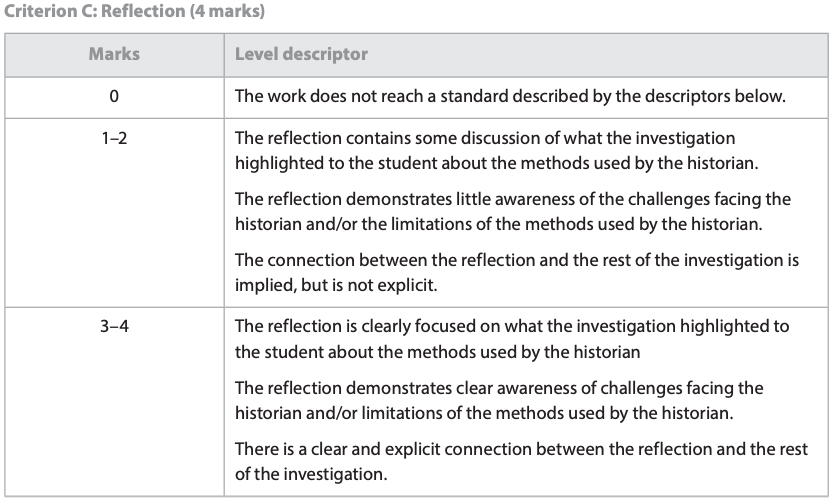
Faux Pas – these actually happened
- Consulting mediums as sources.
- Using confidential information in an IA, i.e. police sources
- To what extent did the US drop an atomic bomb on Japan?
- To what extent did the British evacuate their troops from Dunkirk?
- Ignoring the teacher’s advice!
- Using textbooks as sources.
The Role of the Historian
- When identifying problems researching your topic or writing the investigation, don’t worry, historians have all been there before. Several respectable historians explain the problems of studying and writing history below. Their views may help you with your investigation and reflection for the IA.
- John Lewis Gaddis (Professor of Military and Naval History at Yale University) compares the examination of history to that of a landscape, it cannot be visited by anyone in the present
Subject Reports’ Advice
- Citations must be 100% accurate…use the correct guide then proofread, proofread and proofread.
- Develop a Research Question that is answered with evidence. It should not be answered hypothetically.
- When proofreading, ensure all of your investigation answers the research question. Some IA’s have digressed into other topics.
- Use selected academic evidence which is relevant to your topic. Avoid using generic history sources such as history.com or encyclopedias.
- You must explain the relevance of your two sources to the investigation.
- Primary sources are not more valuable just because they are primary.
- If you use revisionist or orthodox historians, explain what these are.
- If you write that an author is biased because of nationality (a possible limitation), you must give a specific example.
- If you write that a limitation is a translation, again you must be specific. It is too simple to write that a translation is inaccurate.
- Compare and contrast your sources with others, this is the evaluation of perspectives.
- Develop a conclusion or judgement at the end of Section B, not a summary of what you have written. ‘The sources/evidence in this investigation prove that…’.
- For Section C, focus on the role of the historian, not the personal problems you faced. If you think you need more sources, specify which.
